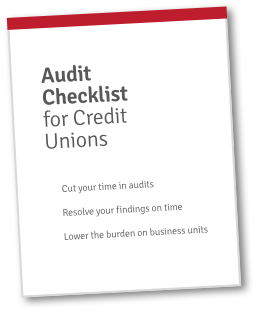Banking has been around for millennia, which shows just how important it is to the world. However, modern banking in our collected world brings new risks and threats. Financial institutions must operate responsibly to see that consumers thrive—and criminals don’t.
Rules and regulations keep everyone safe. But they also keep institutions busy. Credit unions in particular are familiar with the regulatory burden. Their compliance professionals and audit teams ensure smooth and stable operations.
But there are many regulations, and they have teeth. That’s why we’ve identified 10 easy credit union compliance tips to help even the most stressed-out audit teams.
Compliance Tips for Credit Unions
These ten tips may help you fight the good fight.
- Use community support. Two heads are usually better than one, and speaking with other compliance professionals may provide insight about how to handle challenges (or at least have a kindred spirit to gripe with). If you can’t find a local group, try one online.
- Communicate with auditors. Or, if it’s that time of year, get to know your examiner. Establishing good relationships with regulatory officials makes them a willing and valuable resource.
- Read, read, read. You can learn a lot from reading about compliance. You won’t find any page turners, but sometimes you’ll find a good blog. Our favorite is the NAFCU Compliance Blog, but there are many other great ones.
- Organize everything. In many ways, credit union audits and exams are all about dotting your Ts and crossing your Is. Your team should know where to find any compliance documents or information—good file management is key.
- Automate processes. Not all compliance tasks can’t be automated, but a surprising amount can. For example, communications, file organization and management, and audit trails can be automated.
- Create a paper trail. Credit union compliance is about more than just doing the work involved in following regulations—it’s also about showing the work. Creating a paper trail accomplishes exactly that.
- Let software help. Audit management software simplifies organization, workflows, and processes. It’s a platform where audit teams and business users can quickly and easily track items, due dates, and progress, and progress. Plus, it makes audits go by much faster.
- Use outside guidance. Reading may keep you up on the latest in compliance, but supervisory priorities letters and other credit union audit resources really help. Our free audit checklist might also come in handy.
- Leverage experience. You’re surrounded by experienced compliance professionals. If you don’t already have years under your belt, look at your credit union’s past audit findings to learn. Or, even better, ask other compliance pros in your department, talk to your regulators, and see if your partners or vendors can help.
An old quotation goes, “it is better to remain silent and be thought a fool than to speak and remove all doubt.”
Whoever said that didn’t work in compliance, where good communication and understanding are key. A better version would be, “it is better to ask and learn than to remain ignorant forever.”
If you don’t have experience, find somebody who does.
- Take a breather. You’ve earned it. But seriously, if you find yourself getting stressed out, stuck, or overwhelmed, take a break or switch tasks. You can return later with renewed energy.

FREE: Audit Checklist for Credit Unions
4 key principles and 9 questions to jumpstart your audit planning. From leading credit unions.Managing Risk for Credit Unions
We hope we gave you a few useful suggestions. At the very least, the tips above will reassure you in knowing what you already know.
One of the worst feelings that credit union compliance staff can get is the feeling of being unprepared. If you want to see if your credit union is ready for its next exam or audit, we have a tool for you. Our audit and examination scorecard will highlight any issues that you should pay closer attention to.
If you want to speed up audits while reducing errors, contact us to learn more about the Redboard platform.





